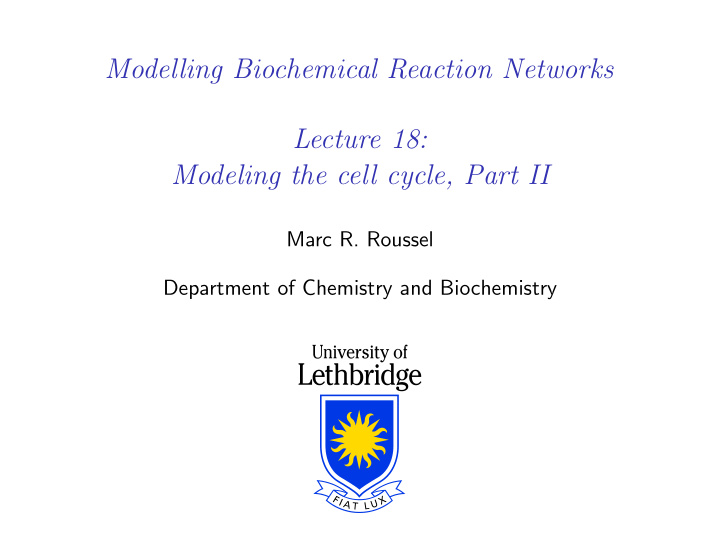



Modelling Biochemical Reaction Networks Lecture 18: Modeling the cell cycle, Part II Marc R. Roussel Department of Chemistry and Biochemistry
Further development of the model ◮ Our model so far includes inactivation of APC by MPF, and tagging of cyclin for destruction by APC. ◮ Activation of APC: ◮ Cdc14 is the phosphatase that activates APC (more accurately, a complex of APC and Cdh1). ◮ Cdc14 is sequestered by an inhibitor known as Pds1. ◮ A complex of APC and Cdc20 tags Pds1 for destruction. ◮ Cdc20 is activated by phosphorylation by MPF. v 4 ◮ The reaction APC inact → APC from our previous model − should therefore be replaced by the sequence of reactions described above.
Further assumptions ◮ There is a constant pool of Cdc20. ◮ Cdc20 is inactivated by an enzyme (known as Mad). ◮ There is a constant pool of Cdc14. ◮ Once Pds1 has been synthesized, it rapidly forms a complex with Cdc14 .
Reactions to be added v 6 v 6 = k cat , 6 [MPF][Cdc20 inact ] Cdc20 inact → Cdc20 − K 6 +[Cdc20 inact ] v 7 v 7 = v 7 , max [Cdc20] Cdc20 → Cdc20 inact − K 7 +[Cdc20] k 8 → Cdc14 Pds1 Cdc14 − v 9 = k cat , 9 [Cdc20][Cdc14 Pds1 ] Cdc14 Pds1 v 9 → Cdc14 − K 9 +[Cdc14 Pds1 ] v 4 v 4 = k cat , 4 [Cdc14][APC inact ] APC inact → APC − K 4 +[APC inact ] Note: The total amounts of Cdc20 and of Cdc14 are constant, so we have [Cdc20] total = [Cdc20] + [Cdc20 inact ] [Cdc14] total = [Cdc14] + [Cdc20 Pds1 ]
Parameters ◮ The reactions in cell-cycle models are often well understood, but most of the parameters are unknown. ◮ Parameters are chosen somewhat arbitrarily, but adjusted to agree with experimental observations (e.g. duration of cell cycle). ◮ The “wiring” (biochemical relationships between species) is generally more important than the parameter values. ◮ In this case, I found that the following parameters gave reasonable behavior by trial-and-error: k cat , 6 = 0 . 3 min − 1 k cat , 9 = 0 . 3 min − 1 K 6 = 10 K 9 = 0 . 3 v 7 , max = 0 . 3 min − 1 k cat , 4 = 1 . 5 min − 1 K 7 = 5 K 4 = 0 . 04 [Cdc20] total = 10 [Cdc14] total = 10
Four-variable model ◮ We now have a four-variable model (MPF, APC, Cdc14, Cdc20). ◮ Take the concentration of Cdc20 as a variable. MPF MPF 0.8 0.8 total Cdc20 = 10 total Cdc20 = 20 0.7 0.7 0.6 0.6 0.5 0.5 0.4 0.4 0.3 0.3 0.2 0.2 0.1 0.1 0 0 0 100 200 300 400 500 600 0 100 200 300 400 500 600 t/min t/min
Bifurcations Bifurcation: a qualitative change in behavior obtained when the parameters of a model are changed Example: Stable equilibrium point − → oscillation ◮ xppaut ’s auto module can be used to analyze bifurcations.
Bifurcation analysis with auto ◮ Start at a steady state. ◮ Start up auto, insert Cdc20total in the parameters. ◮ Set up hI-lo axes as follows: Y-axis : MPF Main Parm : Cdc20total Xmin : 0 Ymin : 0 Xmax : 30 Ymax : 1 ◮ In auto ’s Numerics menu, set Par Max to 30. ◮ Now click on Run → Steady state .
Bifurcation analysis with auto ◮ Grab the point at the end of the stable steady-state branch. This point is labeled HB (Hopf bifurcation). ◮ Click on Run → Periodic . This calculation will show the minima and maxima of an unstable periodic solution. ◮ Grab the last point computed on the branch of unstable periodic solutions, labeled MX . MX is an error label. When computing periodic solutions, it is often due to problems with the number of points used to represent this solution, Ntst in the Numerics menu. Increase this value, say to 40. ◮ Click on Run → Extend . Xppaut will now find a branch of stable oscillatory solutions, again shown as their maxima and minima.
Bifurcation analysis with auto ◮ Grab the last point on the stable periodic branch, then Run → Extend . ◮ Complete the diagram by grabbing the first point, setting Ds to − 0 . 02, and then clicking on Run . ◮ The following diagram should be obtained: MPF 1 0.8 0.6 0.4 0.2 0 0 5 10 15 20 25 30 Cdc20total
Interpretation of bifurcation diagram MPF 1 0.8 0.6 0.4 0.2 0 0 5 10 15 20 25 30 Cdc20total ◮ From [Cdc20] total = 12 . 97 to 15.87, a stable steady state coexists with a stable periodic solution. ◮ Periodic solution corresponds to a cell cycle. ◮ High-MPF steady state corresponds to arrest in S/G 2 /M phase.
Recommend
More recommend